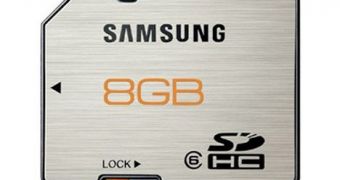Even though moving to smaller processes is getting increasingly difficult and seems likely to somewhat slow down over the next few years, Moore's Law is still very much dictating the rate at which technology advances. As such, it is not exactly surprising to hear that Samsung has managed to complete its 20nm class NAND Flash memory chips, setting the stage for new memory cards that are more capacious and faster than those before them.
The 20nm class MLC (multi-level cell) NAND has a productivity level 50% higher than that of the 30nm-class and its writing performance exceeds that of 30nm-class NAND by 30%, in SD cards of at least 8GB. Also, according to Samsung, 20nm NAND also has a high reliability, on par with that of 30nm NAND, which means that the 32Gb chips the company plans to use in its upcoming SD cards should be superior to predecessors in all aspects. This will raise the performance standard on high-density smartphones and IT applications.
“In just one year after initiating 30nm-class NAND production, Samsung has made available the next generation node 20nm-class NAND, which exceeds most customers’ requirements for high-performance, high-density NAND-based solutions.” Mr. Soo-In Cho, president, Memory Division, Samsung Electronics, said. “The new 20nm-class NAND is not only a significant step forward in process design, but we have incorporated advanced technologies into it to enable substantial performance innovation.”
After more than a year of manufacturing SD cards based on 30nm NAND (it first began in March, 2009), Samsung is now moving up to chips based on the 20nm manufacturing process technology. Samples of SD cards based on it are already shipping to customers, with the actual mass production set to ramp up later this year. Storage capacities will range between 4GB and 64GB, while speeds will be of 20MB/s when reading and of 10MB/s when writing.

 14 DAY TRIAL //
14 DAY TRIAL //